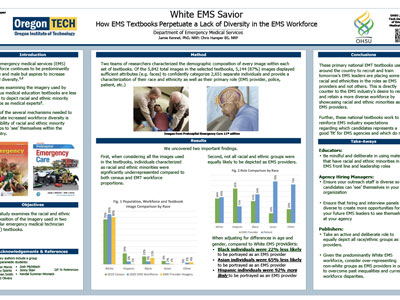ABSTRACTS
Black or Asian, and Female Individuals Are More Likely to be Depicted as Patients in EMS Textbooks, While White Men Are Presented as EMS ProvidersAuthor: Jamie Kennel | | Associate Authors: Chris Hamper | David Olivera | Josh Michlitsch | Wilson Morris | Kendall Womack
Introduction The Emergency Medical Services (EMS) workforce is predominantly White and male and studies suggests it is becoming even more homogenous. Actively presenting opportunities for diverse candidates to see themselves in the current workforce represents a critical step, among many, for the industry to improve its diversity. This study investigates the diversity depicted in the imagery used in two primary national EMS textbooks, as they may represent additional barriers to attracting and retaining a more diverse workforce. Methods We conducted a cross-sectional, retrospective analysis of the images displayed in two widely used national EMS training textbooks. Race/ethnicity, gender, age, and role were categorized for every human image within the two sampled textbooks. We used bivariate and multivariable logistic regressions to compare race and gender representation by role while adjusting for covariates. Results In total, 5144 images were categorized from 2862 pages. Within the images where an individual’s face was visible (2651), 51% were depicted as patients, 44% EMS providers, 2% bystanders, and 3% other. Individuals categorized as Black (aOR 0.78, P < .05) or Asian (aOR 0.35 P < .01) were less likely to be depicted as EMS providers, while individuals categized as Hispanic (aOR 1.92, P < .05) were more likely to be depicted as an EMS provider, compared to images of a White individual. Further, individuals that were categorized as Black (aOR 1.32, P < .01) or Asian (aOR 2.92 P < .001) were more likely to be depicted as a patient, compared to individuals categorized as White. Finally, individuals categorized as female were much less likely to be depicted as an EMS provider (aOR 0.69, P < .001) and much more likely to be depicted as a patient (aOR 1.48, P < .001), compared to individuals categorized as men. Conclusion: Primary EMS textbooks help to set and reinforce expectations about the learner’s feeling of belonging in the career. For the first time, this study finds disparities for Black, Asian, and female individuals in the role of an EMS provider in primary EMS training textbooks. Textbook publishers must take active and deliberate steps to improve the representation of racial minorities and women in EMS training materials. Limitations, implications, and future research directions are discussed.
|

